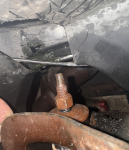The "heater core " is the aluminum and copper heat exchanger inside the plastic housing. If the heater core is leaking, it needs to be replaced. The plastic housing can be repaired by various plastic welding methods. The housing does not hold any pressure and is normally just full of hot air.
If the copper coil assembly inside is not leaking, and you can reach the break in the plastic, you can probably patch it in place. Might not look the prettiest, but if you’re lucky, it should function fine forever.
Is this the crack/hole? Is it that soft, black plastic, almost like a mastic or fiber board that could be bent real easy?
I would go with the baking soda & superglue method
First super clean and super dry the area that’s damaged and maybe a half inch all the way around it. If you could use some kind of little brush and get it really clean inside, that would be good too. I’d use solvent to get any chemicals and antifreeze out of it, And then a scrub brush, maybe a toothbrush, with just dish soap maybe using hot water. Flush it out with hot water, dry it with a heat gun, and then use a little clean brush and just brush it with some lacquer thinner or alcohol to help form the bond
If it’s not laying flat on a table, it could be real messy, but it’s not hard to do, and it doesn’t have to be pretty to work. working quickly, use a Q-tip to dab up some superglue and paint it around the crack. Don’t try to do the whole thing at once. Before the super glue sets, use a popsicle stick or something even smaller than that for little bits of baking soda and stick it onto the superglue. The baking soda makes the super glue set instantly, and the baking soda also acts as a filler. Basically you just go back-and-forth like that until you build an 1/8” thick shield that covers every area of the opening and maybe extended past 3/8 or a half inch. You may also want to paint the outside of it with superglue and certainly give attention to anything that might look like a hole.
If it’s what I think it is, it’s only holding the pressure of the air running through the blower system, and once you use this baking soda/superglue trick, you’ll realize it really gives a pretty strong bond/patch
The only danger is if it’s a different base material, than there are a couple other methods, but this is the one that’s most universal I think. I’ve used it to repair metal gas cans, repair plastic gas cans, little mechanical pieces, whole bunch of stuff.














